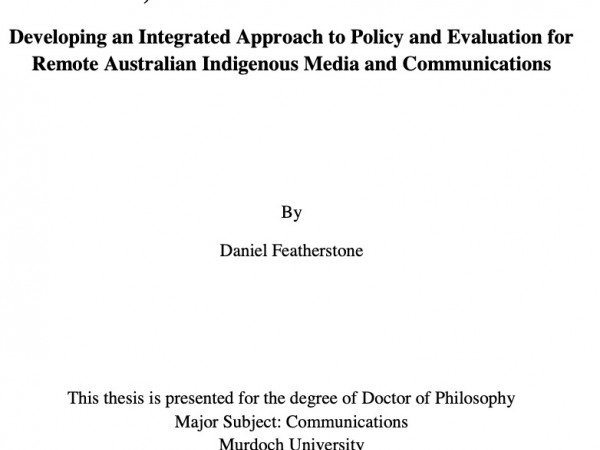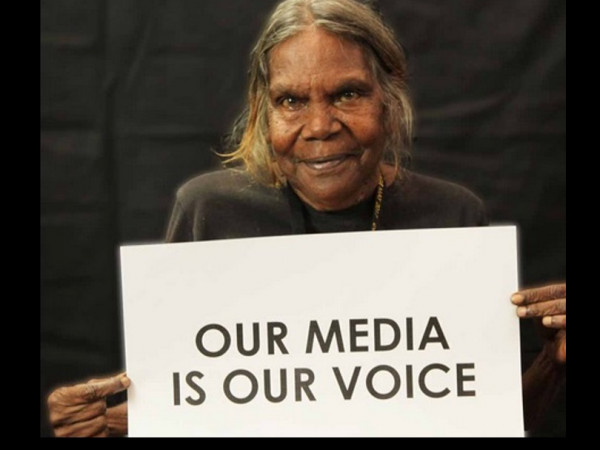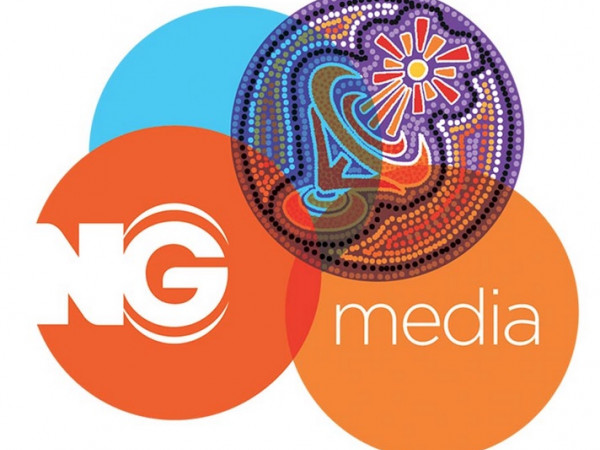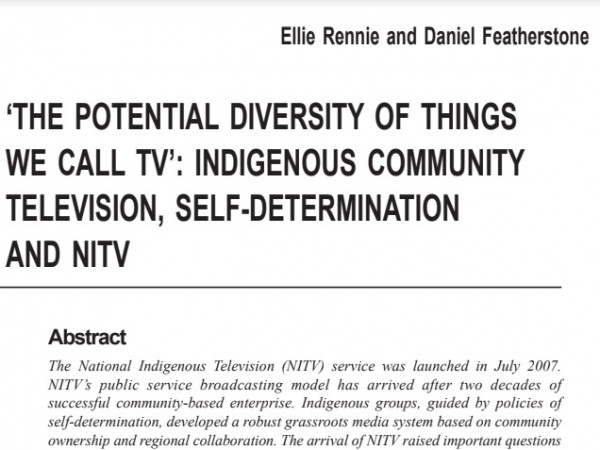Daniel Featherstone
“Video as a tool for cultural continuity”
My name's Daniel Featherstone. I'm currently working with Indigenous Remote Communications Association (IRCA), and worked at Ngaanyatjarra Media for nine years from 2001 to 2010 last year. Originally, I started work in … in late 2001 with Ngaanyatjarra media. I had been working as a cinematographer in Sydney for six years and studied straight from TV school. Previously I'd done a study project into Aboriginal Film and TV back in 1990 and had a sort of a vague understanding of what had happened under the BRACS program and the work with Eric Michaels and so forth, and so had a bit of an interest in remote media.
And felt like you know, something that I've always wanted to explore more deeply and know a bit more about the culture of the country that I've grown up in. And this was certainly an area that was very rich in culture.
…The media programme in the Ngaanyatjarra lands had grown up in Irrunytju community which is right by the Tri-State border -and had really sort of started from the model of EVTV (Ernabella Video & TV, and PY Media) - on a cultural maintenance model. So, videoing, organising and videoing Inma or dance, traditional dance events, documenting the Tjukurrpa, the traditional stories. And you know, videoing, like all community events as well - football and band nights and all different events. And, so it was it was … sort of a video-based programme. The people who were there when I first started were Noeli Roberts and Belle Davidson who'd been involved since the early 90s and had sort of grown the programme up. They had …mostly operated on their own - they'd had coordinators come and go over a number of years. But the programme had really stayed as fairly low key programme - apart from that it had in the late 90s been extended as a regional program to support 12 communities rather than the original one.
Noeli was on the the board of EVTV and PY Media and - as well as Belle Davidson - from I think the late 80s Noli was on, and they had included Irrunytju community as a sort of member community of PY Media in those early days. And so Noeli, through relations across the Pitjantjatjara lands - he's, he's got strong connection that way – had sort of encouraged that they come and, you know, do some of the filming of the Seven Sisters story, in the W.A. side at Keruala - and.. that also led to other filming, you know Warburton and later at Belle Davidson's Sister site - Belle is Sister for Panjiti Mackenzie.
When I first started, it was almost entirely still analogue video. And we were just starting to get … I think one digital video camera at the time. And there'd been a computer editing system set up with Final Cut Pro. So, it was the very beginning days for remote media… using digital media. But pretty much from that time on, in 2001 we've gone entirely with digital media as the primary recording and editing tool. Noeli still liked to get his old Super VHS camera out occasionally and go into a bit of filming,but for the most part they …all went into the archives and…we've sort of moved on into working almost entirely with … digital video, digital audio recorders with mini disc at the time, and …mostly the new the new Zooms and so forth nowadays, all on flash cards. Digital photography started in 2002. And that sort revolutionised the ability of people generally to be able to take their own photos and see them straight away. And so, you know you had kids like taking hundreds of photos of themselves you know, in lieu of having a mirror in their house they got to see their photos on a computer of themselves. And so it made it a lot more accessible, but what it did was also mean that the old skills that Noeli and Belle and others who’d done training under the analogue equipment, editing equipment, the sort of reel to reel, Super VHS and Umatic tapes - all those old skills were lost and they had to re-learn, or effectively what happened was they didn't re-learn - they …handed over to the younger people to start using the computers and the new technologies.
So, as part of our I.T. training that we started doing through the lands, we were creating all this new content. You know, anybody in the community could take photos and turn it into a slide-show, or make a little video and then put it on the computer, and then everybody else could see it, ongoing. It wasn't reliant on broadcasting on TV or radio anymore. So, the computers have really changed not only the way we produce the media, but also the way people access it and are distributing it now.
Broadband in most remote areas is still very low. And so…people don't tend to have computers in their homes. They tend to have community access centres, where they get used to, use of communities. Inthe Ngaanyatjarra communities we rolled out a little sort of tele-centre type arrangements in each community.
Noeli Roberts and Belle Davidson continued to play a key role in the direction that Ngaanyatjarra Media went. So, while we did have a sort of a growth and technology sort of focus I guess, and building the infrastructure in the region, we kept that strong cultural focus as well. So, one of the things that they have done in 1998 was the filming of the Minyma Kutjara Tjukurrpa - the Two Sisters story, going from down near the Nullarbor up towards Irruntjyu community. And that was a project they were always very keen to sort of follow up on. And also getting back to the work that Noli had done over many years, which was to record the Inma, or… like organized Inma events and record those. So, as part of our big incorporation of Ngaanyatjarra Media in 2002, we had a big Inma and a band night and so forth. And people said “Oh, look we want to keep that going”.
So we would, you know go to different communities and host an Inma event for the… Tjukurrpa for that region, for that community. And documenting the cultural stories, and like the Minyma Kutjara Tjukurrpa. We did a second version of that in 2008, leading from Irruntjyu … the next stage going up to Docker River, and documenting the story at 18 sites along the way. So that was about two weeks of filming, and Neil Turner came down from Broome and helped facilitate that. And that was a really powerful story bringing together about 40 of the old people. There was, there were women's sites that we didn't film - we chose that this would be a public version of the story. So, we opted out from including the women's stories, although they were documented separately. And the women's recording programme has always been a very strong programme. They have quite a major ….women's only collection at Ngaanyatjarra Media….
There's a men's only cupboard and a women's only cupboard at Ngaanyatjarra Media. And they…so you know, the key for that is held by Noli and Belle as the cultural officers of Ngaanyatjarra Media - they take that responsibility to look after that material, go out and do the filming and work with the women, you know to document that, and also to sort of bring it out for viewing in the appropriate forum. So, we have a space there where they can watch the material as well, and that helps to again….It's more of a teaching tool really. You know, if anything what the roles that Noli and Belle have taken on are teachers for the next generation - particularly on Ngaanyatjarra side, the Mission sort of prevented people from learning the dances and their…. and maintaining the culture, less so than on the Pitjantjatjara side, through the Ernabella Mission. So, there was a generation there that really lost that continuity of knowing the songs and dances - including Belle. And Belle actually learnt a lot of those songs and … how to do the dances properly, from watching the videos that Pantjiti and Mr. Mackenzie had been filming over many years - watching the way the old ladies danced and hearing the songs and remembering them, and then teaching a lot of the people on the Ngaanyatjarra side. And so, it was …video played a really important role in that cultural continuity. And so, yeah the work that Ngaanyatjarra Media has done has been very much in that vein, to sort of keep video as a tool for cultural continuity, to really see the recording of those stories, of getting the old people before they pass on, to tell their stories and to keep that as a part of the heritage of the lands. And that will keep going - while Noli and Belle are around, and with the next generations coming through and learning that model just as they learnt it from EVTV. I think that will continue on.
Look, there's been a number of developments of Indigenous television over the years. Obviously, the sector has always pushed hard to have an Indigenous Television service in Australia right back, going back to the ‘80s. In the late ‘90s there were test broadcasts done when Imparja up a second narrowcast channel - just Channel 31…
… that was available if we wanted to start using it. So PY Media, being very proactive at the time, set it up so that they would broadcast the weekend football games that were being played in Alice Springs here. And they had a little, a little wireless link that they would link that over to Imparja, and put it on Channel 31. And following that football broadcast each weekend they played out a three-hour compilation of videos that they'd made, and from other regions across Australia. And so that was really the beginning of ICTV. In 2002 we all - each of the remote media organisations, it was four, four main ones that were originally involved. That was PY Media, PAW or Warlpiri Media, PAKAM - Pilbara and Kimberley Aboriginal Media, and Ngaanyatjarra media. We all just began sending videos into Imparja, and they ingested those and started a play out on the system - I think it started out at a couple of hours, two or three hours a day, and slowly built up over time to, by 2004 5 we had pretty much a full time service going.
And so by the end of 2006 we had 147 communities absolutely loving seeing Indigenous community TV as one of their full time channels. And the amount of product or content going up … just took off, because everyone saw that they could put their videos in and get them on air. So, it just started to take off. Unfortunately, in the middle of the next year we lost use of that channel when NITV was established.
Look, we continued to support the model of an of an Indigenous TV Service. We always - from the remote sector - thought that, that's a really good thing. You know Australia needs to have a profile for Indigenous television. And the type of programming that would go to a mainstream audience into, you know, cities and towns and so forth, was a very different type of programming than what ICTV was delivering, which was intended entirely for remote communities. It was really more about having language programming and having people being able to see their own stories, their own people on TV.
First of all, the government insisted that there be a single service and that everyone worked together. But it didn't follow through to implement the business plan that had been put together, which did allocate an eight-hour block for an hour for remote content. In fact, it left the programming model up to the board of NITV, which…there was a number of players on that board who were very instrumental in in the model that they ended up going with, which was very much a black SBS – a mainstream type model.
It would have made more sense to have more of a mix of you know, the community content and the high end content - and certainly you know,that was there for a while …but when we did start trying to develop a production for remote content, of compiling what we saw as sort of the cream of the crop of the remote content that would be appropriate to a broader audience it got lost in the whole commissioning process. It took a year and a half of negotiations and eventually fell apart just because it was…There wasn't a lot of buy-in for that type of content.
I think there was a number of…serious breakdowns in the model that they went with. The commissioning process insisted that NITV would own the intellectual property on anything that they commissioned - whereas the remote sector, you know, just simply couldn't hand intellectual property of cultural content over to another agency…
The original concept of television in remote areas was not to broadcast their stories out to the rest of the world. It was to broadcast them to each other, to themselves as a community. It was to keep the language and culture going, and speak to the next generations and …use this as a tool for both cultural maintenance but also for intergenerational knowledge transfer. So, it was really a case of having, like seeing the recording of cultural and… community information… as a holding place. Not as a promotion or a, or a, you know, as a communicating with the broader world. So, I think that… the notion of - you know, Eric Michaels referred to this in the differences at the time the BRACS was being talked about - of this sort of pan-Aboriginalist model, of expecting all Aboriginal people to take on a sort of a similar identity, as compared with a cultural maintenance model which is very much about maintaining the intricacy, what is different and unique about a particular place and a particular cultural identity. And you know, my experience at working at Ngaanyatjarra Media has been very much along a similar line to what was established at Warlpiri Media and Ernabella Video and TV with that sort of cultural maintenance model.
People have criticized Michael's for all sorts of things but, you know, …he had passion. He was coming in at a very politicized moment of globalization of, you know this self-determination in Australia that was strong at the time…and cultural maintenance was a sort of a key word for localism as compared with globalism. And I think he was bringing a whole lot of his own politic…. from the United States into his work in Australia. But, having said that he helped to pave the way for the BRACS program for communities to be telling their own stories. And for that to be recognised as significant.




